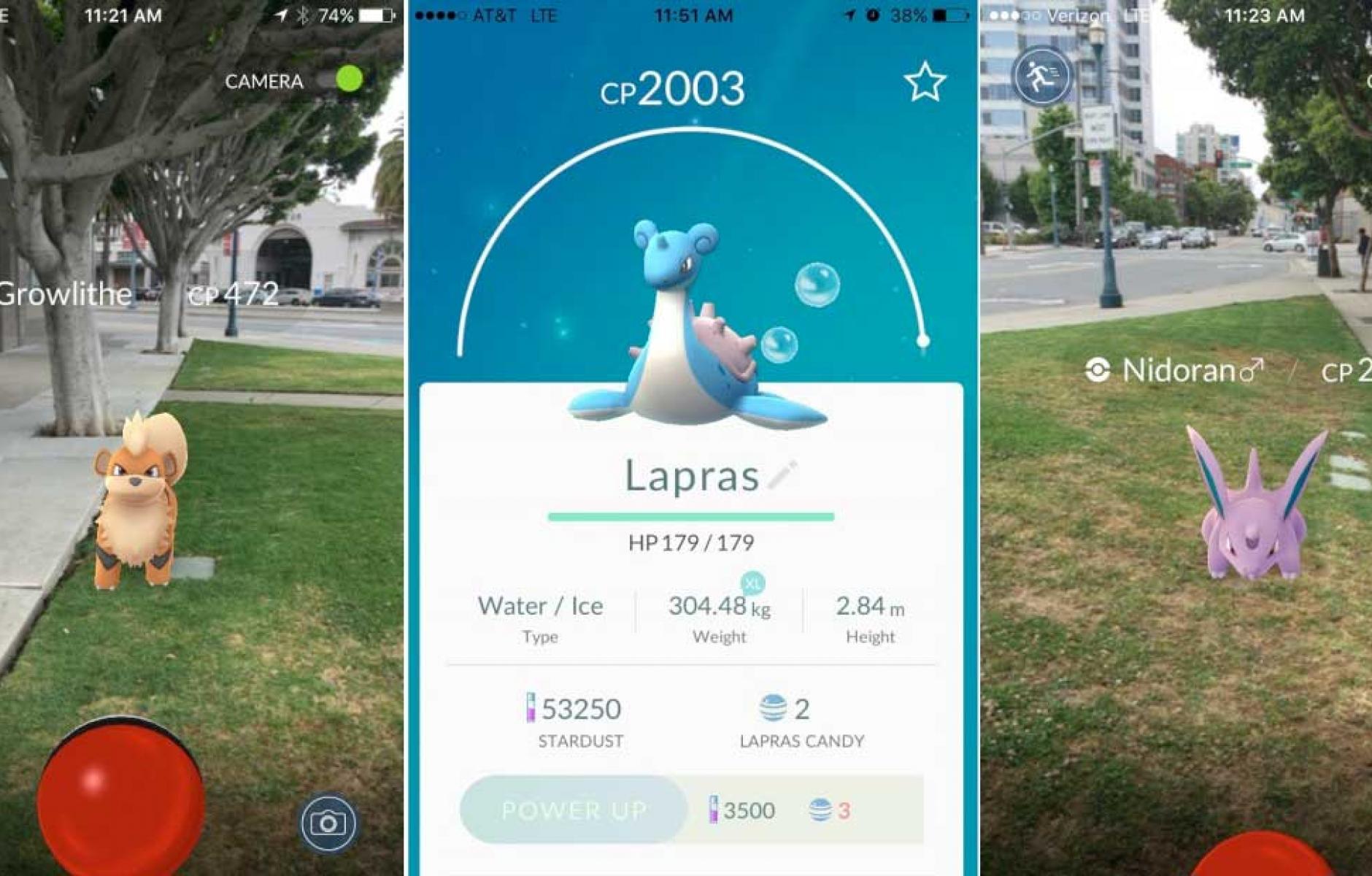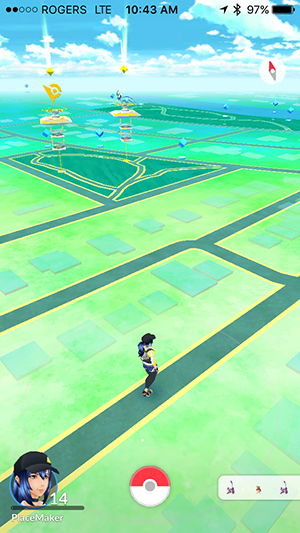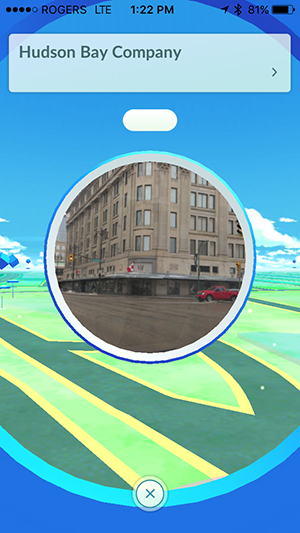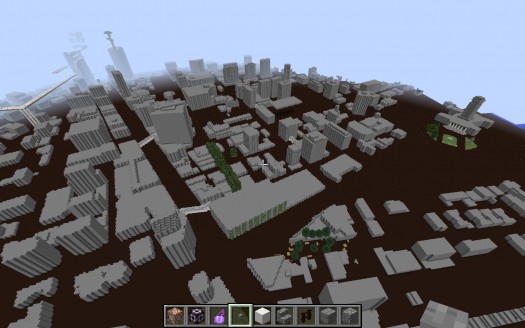
The walkable, urban world of Pokemon
“Mom, I need to walk 10k today,” coming from my 11-year old this morning almost gave me whiplash, as I turned to look at him to ensure an alien wasn’t inhabiting his body. In fact, there was one, if you view Pokémon as other-worldly. The playful new video game, Pokémon GO, is distracting kids and grown-ups alike with an augmented reality (AR) that requires walking with friends, visiting places of cultural and economic significance, and “capturing” Pokémon as they appear on the sidewalk by “hitting” them with virtual balls. By level five of the game, you’re able to join a team and visit local virtual “gyms” to practice or spar. The walking 10k comment was about hatching Pokémon eggs, each of which require walking either two, five, or ten kilometers.
The reviews on this wildly popular one-month-old game are mixed, with some people complaining that kids are walking around like zombies, dogs are exhausted, grown-ups are invading private property and thronging parks in search of Pokémon, and one woman got hit by a car while being distracted by playing the game. All valid complaints, although in our household a few simple rules – like no looking at your phone while crossing the road and pausing to talk about the places of note that we find – do away with most of the issues. Except privacy, of course! Nonetheless, 100 million people have downloaded the game, are buying $10 million a day on the app, and are significantly increasing foot traffic in their home towns.

From an urbanist’s perspective, the game’s use of Google Maps to set the stage as a moving backdrop is fabulous fun and helps kids learn how to read the plan view. The game developer, Niantic, is an internal startup from within Google. In our household, Pokémon GO sparks all sorts of conversations about the urban form of different neighbourhoods: “Hey, look at how tight these setbacks are. No wonder it’s fun to walk here – it feels like an outdoor room.” Or “I guess the laws about how to build aren’t really working here, because new stuff is out of character with old stuff. Look how jagged the buildings look on the plan.” Or “Why does the game show the alleys the same size as the streets? They’re obviously skinnier, as they should be.”
A bevy of economic impacts are being felt by the game, with Business News Daily laying out strategies for small business, like offering Pokémon GO social media deals, or hosting a lure party, gym battle tournaments, or a Poké-hunt. The game rewards both walking and walking with friends, so the more people who are moving through a neighbourhood together, the more Pokémon are attracted to the area.
Business Insider points out that people are starting to make restaurant choices based on PokéStops, lures, and gyms. They question, “If you are a restaurant or bar and aren’t spending at least $10 a day on Poké lures and advertising the fact, what are you even thinking?”

The game celebrates art, architecture, and culture, so businesses near cultural landmarks have a better chance of having PokéStops, which is what you need to be able to place a lure. Forbes points out that some art museums are including them in their didactic material.
By the way, said 11-year old is now reading over my shoulder. “Mom, do you have a bibliography? Can you text it to me?”
Inc. Magazine expounds on how Pokémon GO is driving insane amounts of sales at small, local businesses, at a mere $1.19 per hour to purchase lures. The game now has more active users than Twitter! I’m still trying to take in that serious fact. Inc. suggests that if your business isn’t a lucky PokéStop or gym owner, you should take to the streets to sell wares near clusters of PokéStops, where you’ll need to set lures. It’s that big.
For fellow city planners, clearly you need to purchase lures for your next community design workshop or charrette, and let people know about them on social media. Even the presidential candidates are using the game for campaign purposes. But you may want to let the lure expire when your workshop mingle period is over.
We tried something similar but more involved with a different video game recently, and were delighted with the results. My city of Winnipeg, Manitoba, has an advanced downtown business improvement district, the Downtown BIZ, which is updating their three-year strategic plan. Since it’s summertime, we took extra care to engage local kids to hear their vision for how to take downtown from good to great.
My 11-year-old had a great idea, and that was to model our downtown with a to-scale version in Minecraft. He and a friend then hosted a series of Minecraft Lounges to let kids collaborate on what they’d like their downtown to evolve into over time. It was delightful to watch them negotiate about their possible future, and propose some rather outlandish ideas that adults would be unlikely to pose.

More in-depth coverage on CBC, Metro News, Global TV, and myToba.
Geek alert: here’s a high-level explanation of how to do this at home. It’s only feasible if you have a great local SketchUp model for starters. We took a SketchUp model of downtown Winnipeg (extra fine version contributed by the Winnipeg Art Gallery and Cibinel Architects), carefully scaling it up in CAD (via technology jockey, Taylor Clackson, at BLDG Architecture Office Inc.). Then PlaceMakers used binvox to convert the SketchUp to a schematic. Then the kids took over, using MCedit to convert the schematic to a Minecraft file, and created a Minecraft Lounge using a hotspot on an iPhone as a local area network to connect five computers (that’s the max, unless you want to host it separately).
The kids most involved in the project started looking at downtown in a different way this summer. They started to see the patterns of character, and what made some blocks lovable and others scary. They learned how to take Minecraft to a community level, mining for resources and crafting solutions. To potentially augment reality in a way that could be for real. They learned the basics of community facilitation: how to set parameters, listen, and encourage hard questions. They made me proud.
One of the underlying realities that the Pokémon GO is uncovering is how much time people are spending indoors gaming these days, particularly since those 100 million downloads didn’t appreciably reduce downloads of other apps. It begs the question how much of its success is to do with the fact that the more urban places have more PokéStops and gyms. When those of us who don’t live in inner cities have a new incentive to go walk the streets of immersive urban environments, we may go for the Pokémon, and stay for the experience.




